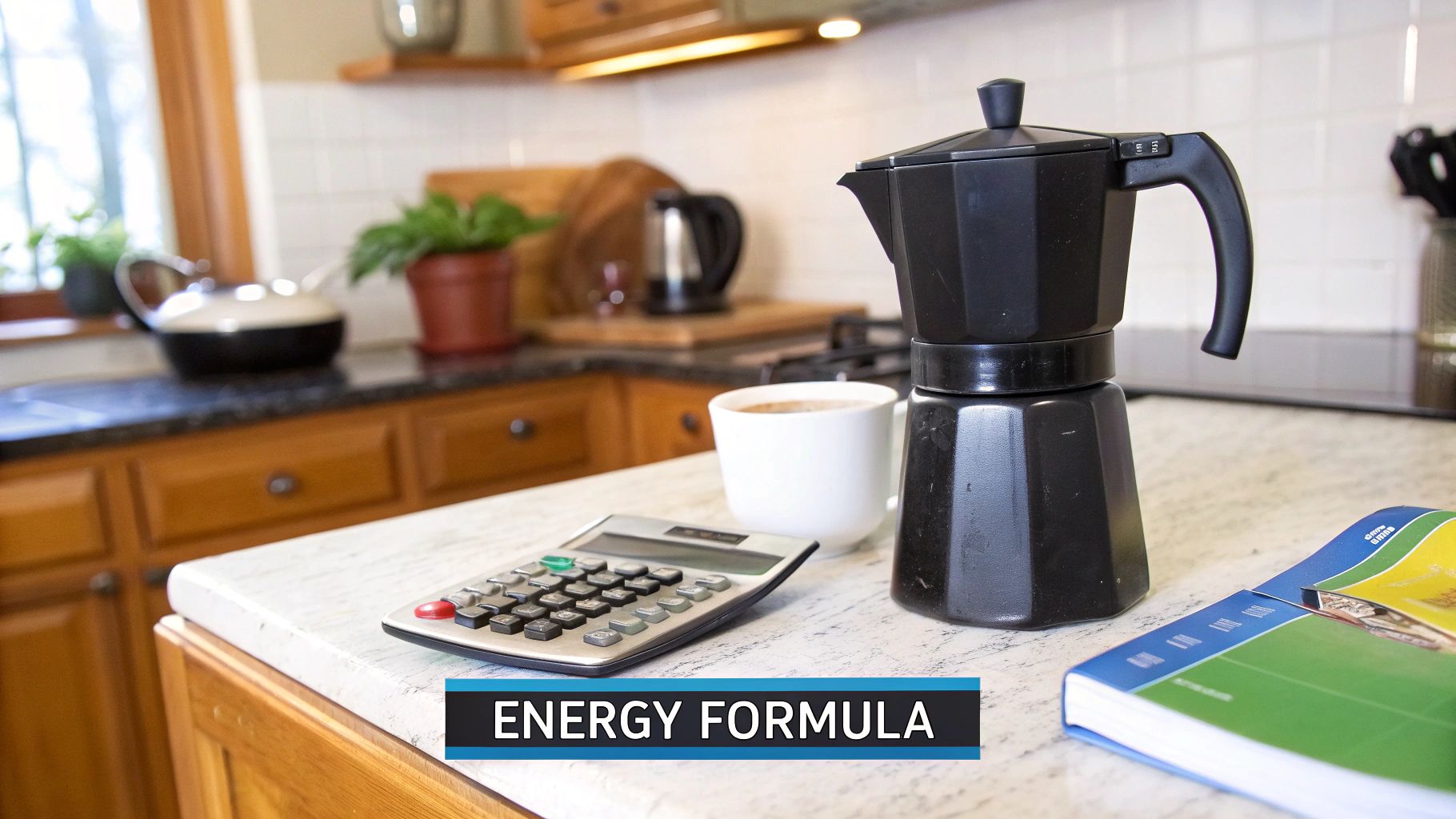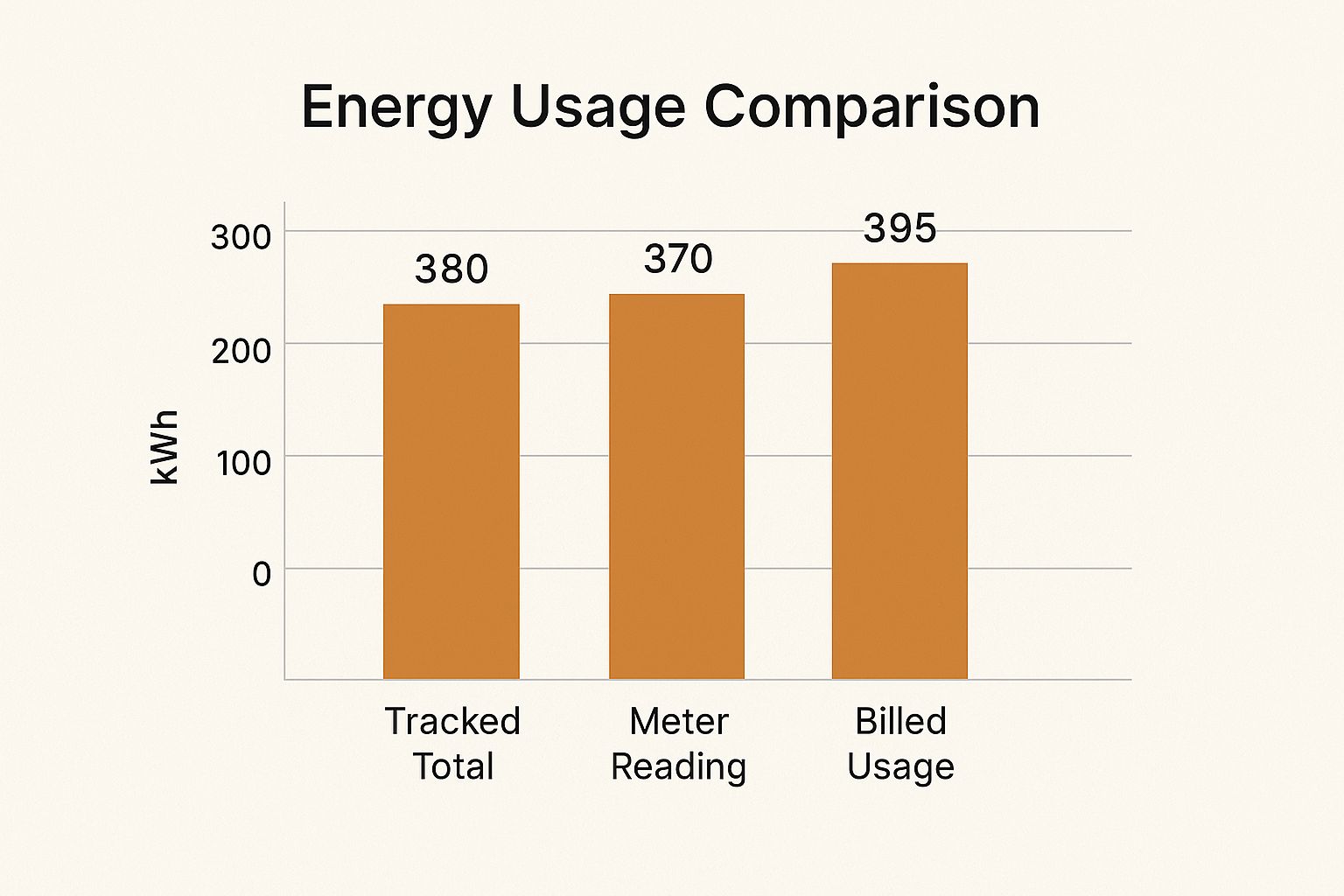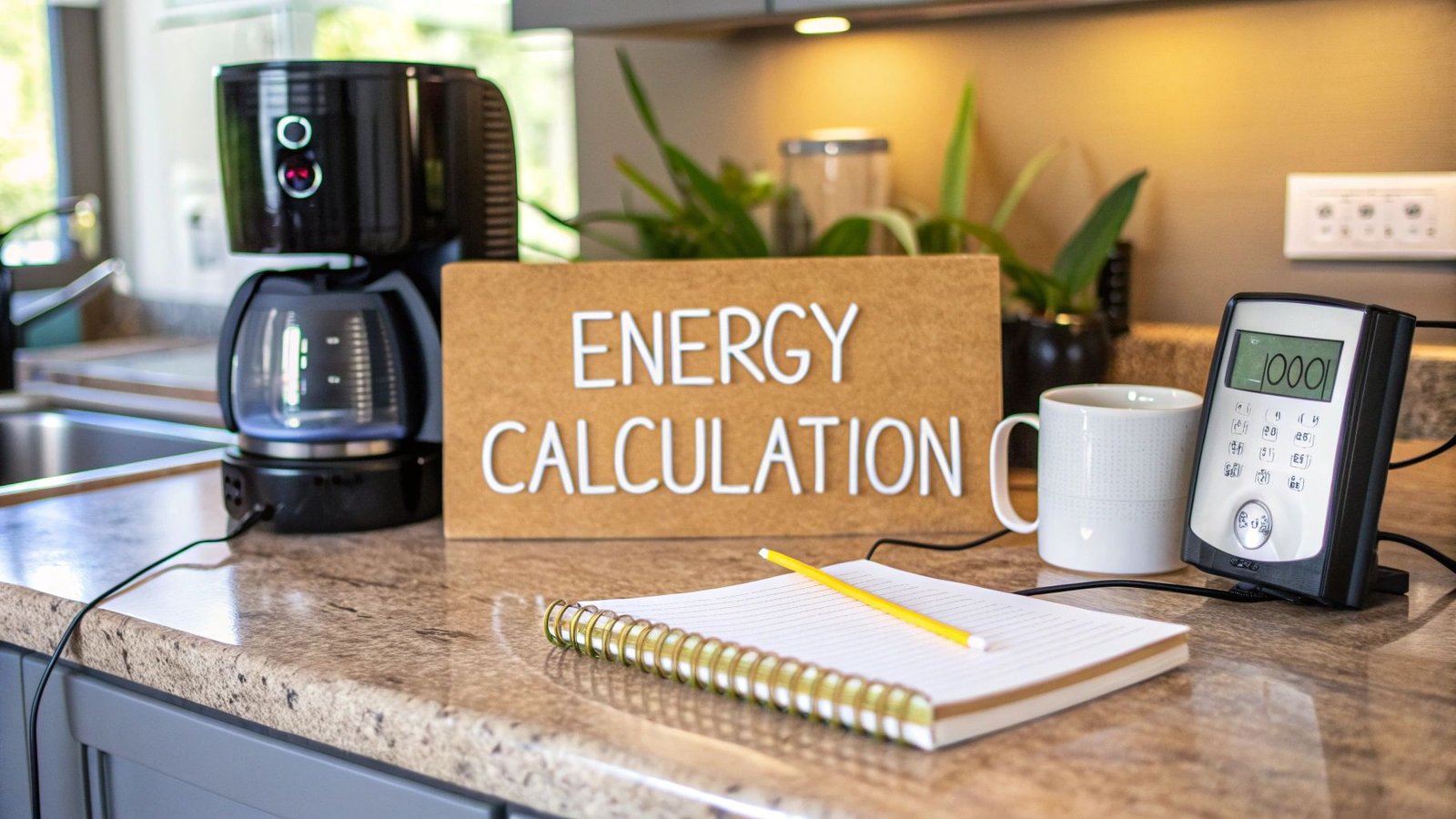Ever wondered where all the energy on your utility bill actually goes? The good news is, you don't need to be a math whiz to figure it out. The secret lies in a surprisingly simple formula.
At its core, calculating your energy use comes down to this: Appliance Wattage × Hours Used ÷ 1000 = Kilowatt-hours (kWh). This little equation is your key to decoding your electricity bill and finally seeing which devices are the real energy hogs in your home.
Your Quick Guide to Calculating Energy Use

Before we start crunching numbers, let's get the terminology straight. Think of Watts (W) as the amount of power an appliance draws right now—like how fast a car is going. Kilowatt-hours (kWh), on the other hand, is the total amount of energy used over a period of time. It's the "distance traveled," and it's what you're actually billed for.
Just remember, one kilowatt is equal to 1,000 watts.
So, if you leave a 100-watt light bulb on for 10 hours, it consumes 1,000 watt-hours, which is exactly 1 kWh. It's a fundamental concept that applies to every single thing you plug in. If you're curious about the bigger picture, the 2025 Global Energy Review offers some fascinating insights into worldwide energy trends.
A Practical Example
Let's put this into practice with a daily habit: making coffee. A standard drip coffee maker might pull around 1,200 watts. If it takes about 15 minutes (0.25 hours) to brew a full pot, the math looks like this:
- Calculation: 1,200 W × 0.25 hours = 300 watt-hours
- Conversion to kWh: 300 Wh ÷ 1000 = 0.3 kWh
That single pot of coffee costs you 0.3 kWh. Now, imagine applying that same simple logic to your TV, your computer, and your microwave. Suddenly, you start to get a very clear picture of your home's energy profile.
Key Takeaway: The point isn't just to calculate a number. It's about understanding how small, everyday actions add up. Those seemingly minor energy uses can have a surprisingly large impact on your monthly bill.
Quick Appliance Energy Calculation Examples
To give you a head start, here's a quick reference chart showing typical power draw and sample daily energy consumption for some common household items.
| Appliance | Average Power (Watts) | Daily Use (Hours) | Daily Energy Use (kWh) |
|---|---|---|---|
| Refrigerator | 150 W | 8 hours (cycling) | 1.2 kWh |
| 55" LED TV | 80 W | 4 hours | 0.32 kWh |
| Laptop | 65 W | 6 hours | 0.39 kWh |
| Microwave | 1000 W | 0.25 hours (15 min) | 0.25 kWh |
| Gaming Console | 150 W | 2 hours | 0.30 kWh |
Use this chart as a starting point. Your own appliances and usage patterns will vary, but this gives you a solid idea of which devices are worth a closer look.
Finding the Wattage of Your Appliances
Before you can figure out how much power any device is using, you need to find one key number: its wattage (W). Think of wattage as the rate of power consumption—it's the foundation for all your energy calculations. Luckily, manufacturers usually put this information right where you can find it, as long as you know where to look.

Most appliances have a compliance plate or sticker somewhere on them. It’s often tucked away on the back, the bottom, or even inside a door. This little label is packed with technical specs, and it's your go-to source for the wattage. On a refrigerator, you'll likely find it on the back or inside the main compartment. For a TV, check the back panel near where the cords plug in.
What to Do When the Wattage Is Missing
Every now and then, you'll come across an appliance where the label is missing, worn out, or only lists volts and amps. Don't worry, this happens all the time, and there's an easy fix. You can calculate the wattage yourself with a simple formula:
Watts = Volts × Amps
In the U.S., a standard home outlet provides 120V. So, if you glance at the label on your vacuum cleaner and it says “8A” (which stands for 8 amps), you can just plug that into the formula:
- 120 Volts × 8 Amps = 960 Watts
And just like that, you've got the number you need. This quick conversion is essential for getting a complete picture of your home's energy use, especially for older devices where the wattage isn't clearly marked.
For a More Precise Reading, Use a Usage Monitor
If you want to get serious about accuracy, an electricity usage monitor is the way to go. These are fantastic, affordable gadgets that are especially useful for electronics with different power modes, like a computer or a gaming console. You just plug the monitor into the wall and then plug your appliance into the monitor.
This little device gives you a real-time reading of exactly how much power an appliance is drawing. It’s perfect for answering all sorts of practical questions:
- How much power does my TV really use when it's on compared to when it's in standby mode?
- Is that old freezer in the garage secretly driving up my bill?
- What’s the actual energy cost of my entire home office setup?
An electricity monitor completely removes the guesswork. Instead of relying on a manufacturer's estimate, you get hard data from your specific appliance, running in your home. This is the key to spotting those hidden energy vampires and getting truly precise calculations.
Using one couldn't be simpler. Plug it in, let your appliance run as it normally would, and the monitor will show you the exact wattage. Many models can even track total kilowatt-hours over time, giving you a crystal-clear understanding of your device's true energy footprint.
Seeing the Bigger Picture of Your Home's Energy Use
Figuring out how much power your coffee maker uses is a great start. But the real "a-ha!" moment comes when you zoom out and see how everything adds up. This is where you connect the dots between individual devices and your home's total energy footprint. It’s the difference between knowing one player’s stats and understanding how the whole team performs.
A simple way to begin is by creating a home energy audit on a basic spreadsheet. List your major appliances in one column and their daily kWh usage (from your calculations) in the next. Then, just sum it all up. This pie chart shows a typical breakdown of where electricity goes in an average home.
pie
title Typical Home Electricity Consumption Breakdown
"Heating & Cooling" : 47
"Water Heating" : 14
"Lighting" : 12
"Refrigerator" : 8
"Electronics" : 6
"Washer & Dryer" : 5
"Other" : 8
This little exercise is often an eye-opener. It quickly shows you where the real energy hogs are hiding. You might be surprised—is it the refrigerator humming along 24/7, the air conditioner kicking on every afternoon, or that tangled mess of chargers and gadgets on standby? Your audit will point you in the right direction.
For a more detailed look at your home's potential, our guide on using a solar energy calculator for home use can help you translate these numbers into real-world savings.
Check In With Your Electric Meter
Once you have a rough total from your appliance audit, it’s time to go check the official scorekeeper: your electric meter. This device is the final word on your home's consumption, tracking every single kilowatt-hour that comes through the line.
Learning to read your meter gives you a crucial baseline to compare against. You’ll likely have one of two types:
- Digital or Smart Meters: These are the easiest. They have a digital display that shows a cumulative number, usually labeled kWh. Just write down the number, wait exactly 24 hours, and write down the new number. The difference is your home's total usage for that day. Simple as that.
- Dial Meters: These older models look like a row of little clocks. It can feel a bit counterintuitive, but you read the dials from right to left. If a pointer is between two numbers, always record the smaller one. The principle is the same—compare readings over time to find out how much you’ve used.
This direct reading is priceless. It catches everything, including the "phantom loads" from devices in standby mode that you probably missed on your spreadsheet.
Compare Your Findings to Your Utility Bill
The final piece of the puzzle is to square your numbers with your monthly utility bill. Think of your bill as the official report card. Seeing how well your own calculations line up with it is where you confirm you're on the right track.
Your utility company uses highly accurate metered data to generate that bill. If you're curious about how energy data is tracked on a massive scale, the Energy Institute's statistical review offers a fascinating look into the methodologies used by large organizations.
On your own bill, look for a line item like "Total kWh Used." To find your average daily use, just divide that number by the number of days in the billing cycle.
Now, you have three key data points to compare:
- Your spreadsheet audit total
- Your 24-hour meter reading
- Your average daily use from the bill
They probably won't match perfectly, and that's completely normal. The chart below shows a typical example of how these three numbers might look for a given month.

These small discrepancies are expected, but by cross-referencing all three sources, you get a much more accurate and reliable picture of where your energy—and your money—is really going.
Turning Kilowatt-Hours into Dollars and Cents
Knowing your home uses 30 kWh a day is interesting, but what does that actually mean for your wallet? The real power of tracking your energy use comes when you connect those abstract kilowatt-hours to real money. This is where your quick calculations become an amazing budgeting tool, showing you the direct financial hit of your daily habits.
The first thing you’ll need is a recent utility bill. Somewhere in all those line items is the number we’re looking for: your electricity rate. This is the price you pay for every kilowatt-hour, usually shown in cents per kWh (like $0.14/kWh).
If you’re having trouble finding it, our guide on how to read electricity bills can help you pinpoint the exact figure. Once you’ve got that rate, the math is refreshingly simple.
Calculating an Appliance's True Cost
Let’s take a look at a common energy hog: a window air conditioner. A typical unit might pull about 1,500 watts, which is 1.5 kW. If you run it for 8 hours on a hot day, here’s what its consumption looks like:
- 1.5 kW × 8 hours = 12 kWh
Now, let's say your utility charges you $0.15 per kWh. To figure out the daily cost to run that AC, you just multiply:
- 12 kWh × $0.15/kWh = $1.80 per day
That might not sound like a lot at first glance, but it adds up fast. Over a 30-day month, that single appliance is adding a whopping $54 to your bill. This simple math changes your perspective from "the AC uses a lot of power" to "that AC is costing me nearly sixty bucks a month."
This is the key to making smarter choices. When you realize an old, inefficient fridge in the garage is costing you $20 a month to run, the idea of buying a new ENERGY STAR model suddenly makes a lot more financial sense.
What About Time-of-Use Pricing?
Things get a little more interesting if your utility uses a Time-of-Use (TOU) plan. This is becoming more common. With TOU pricing, the cost of electricity changes depending on the time of day. It’s most expensive during “peak” hours—usually late afternoon into the evening—and cheapest during “off-peak” hours overnight.
This completely changes the game. It’s not just about how much energy you use, but when you use it. For instance, running your dishwasher at 9 PM instead of 6 PM could literally cut its operating cost in half. This is also a huge factor for homeowners considering renewables, as global trends show a massive shift toward wind and solar power generation. If you're curious about the bigger picture, the Global Energy Outlook 2025 from Resources for the Future offers some fascinating insights into where our energy is headed.
To see how much of a difference timing can make, the following chart illustrates the cost to run a clothes dryer at different times of the day.
graph TD
subgraph Dryer Cost (2 kWh use)
A[Peak Rate: $0.28/kWh] --> B(Cost: $0.56)
C[Mid-Peak Rate: $0.18/kWh] --> D(Cost: $0.36)
E[Off-Peak Rate: $0.12/kWh] --> F(Cost: $0.24)
end
The difference is stark. Simply by shifting high-energy tasks like doing laundry, running the dishwasher, or charging your EV to off-peak hours, you can see some serious savings without actually using less electricity overall. It’s all about timing.
Using Your Data to Make Smarter Energy Choices

Alright, you've done the detective work and crunched the numbers on your home's energy consumption. Now for the fun part: turning that data into real savings. This isn't about guesswork anymore. You have a personalized roadmap to make targeted changes that will actually shrink your monthly bill.
The numbers you've gathered should guide every decision from here on out, ensuring your efforts aren't wasted. You can now move from simply understanding your usage to actively managing it. As technology continues to evolve, even more advanced tools are emerging; for a look at what's on the horizon, check out this piece on AI's role in electricity management.
Tackle the Obvious Energy Hogs
Your energy audit probably lit up a few key culprits like a neon sign. Was it that ancient, rumbling freezer in the garage? Or maybe the power-guzzling space heater you run all winter? These high-draw appliances are the perfect place to start.
Let’s run a real-world scenario. Say your audit revealed that old freezer is costing you a whopping $20 a month. A brand new, ENERGY STAR certified model might set you back $600. Is it worth it? Let's do the math on the payback period.
- Calculation: $600 (New Freezer Cost) ÷ $20 (Monthly Savings) = 30 months
In just two and a half years, that new freezer pays for itself. After that, you're pocketing pure savings month after month.
Eliminate Phantom Load for Easy Wins
One of the sneakiest energy drains homeowners discover is something called phantom load. This is the power that electronics sip on even when they're turned "off" but still plugged in. It's easy to miss in your calculations, but these little energy vampires can account for up to 10% of your total electricity bill.
Pro Tip: Your home entertainment center is a prime suspect. The TV, soundbar, gaming console, and streaming devices all pull a small but constant current. An easy fix? Plug them all into a smart power strip that completely cuts the power when they aren't in use.
This same strategy works wonders for home office setups and kitchen counters. Any spot with a cluster of gadgets is a perfect candidate for a power strip to stop that wasteful standby drain.
Optimize Your Thermostat and Lighting
Your heating and cooling system is almost always the single biggest energy user in any home. Now that you have hard data, you can make much smarter choices with your thermostat. You'd be surprised how much you can save over a year just by adjusting the temperature by a few degrees.
Lighting is another area that's ripe for an upgrade. Your audit might have shown that those old incandescent or halogen bulbs are costing you a fortune. Swapping them for energy-efficient LEDs is one of the fastest ways to see a return on your investment.
Just look at the difference:
- A 60W Incandescent Bulb uses 0.06 kWh every hour.
- An equivalent 9W LED Bulb uses only 0.009 kWh per hour.
That's an 85% reduction in energy use for the exact same amount of light.
To take your savings to the next level, you can get strategic about when you use power. Many utility companies offer different pricing tiers throughout the day. Learning more about time-of-use electricity rates can unlock a whole new way to save by simply shifting your usage to off-peak hours. When you combine efficient tech with smart timing, you really start to take control of your energy bill.
Got Questions About Home Energy Use? We've Got Answers.
Even with a clear plan, you're bound to run into some questions once you start digging into your home's energy habits. That's completely normal. Let's tackle some of the most common things homeowners wonder about when they first start calculating their energy consumption.
Getting these details sorted out is what helps you move from just crunching numbers to making smart, money-saving changes around the house.
How Accurate Are My Calculations Compared to My Utility Bill?
Your personal calculations are a fantastic tool for getting a handle on things, but don't expect them to match your utility bill down to the last kilowatt-hour. It's rare that they will.
The main reason for this is that the wattage listed on an appliance is often a maximum or an average. In the real world, its actual power draw goes up and down. You also have those sneaky "phantom loads" from devices in standby mode, which are easy to miss.
Think of your calculations as your strategic guide and your utility bill as the official final score.
That said, a huge difference between your numbers and your bill can be a red flag. If your bill is consistently way higher than what your detailed audit suggests, it might point to a failing appliance or even a problem with your meter.
A small variance of 5-10% is perfectly fine. But if you're seeing a gap of 25% or more, it’s probably time to do some digging.
What Is Phantom Load and How Do I Measure It?
"Phantom load," sometimes called standby power, is the electricity your electronics use even when they're turned off but still plugged in. We're talking about your TV, your gaming console, your coffee maker, and all those phone chargers. They're all constantly sipping a little bit of power, 24/7.
You could use an electricity usage monitor to measure them one by one, but there's a simpler way to see the big picture. Go to your main electric meter, turn off and unplug everything you possibly can in your house, and then check the meter. The amount of power it's still drawing is your home's baseline phantom load.
A great way to kill this waste is with smart power strips. I use them for my entertainment center and home office setup. They completely cut the power to your devices when you’re not using them, stopping that constant, unnecessary drain.
My Appliance Only Lists Amps. How Do I Find the Watts?
This comes up all the time, especially with things like power tools, kitchen gadgets, or older appliances. Luckily, the conversion is super simple with a formula you can use right on the spot:
Watts = Volts × Amps
In a standard U.S. home, the voltage is almost always 120V. So, if you have a device that says it pulls 5 Amps, the math looks like this:
- 120 Volts × 5 Amps = 600 Watts
And just like that, you have the wattage you need to plug into the main energy consumption formula. This quick bit of math makes sure no device gets left out of your home energy audit.
Ready to take control of your energy future and significantly reduce your reliance on the grid? At Radiant Energy, we provide high-quality solar energy solutions to help homeowners like you achieve energy independence. Learn how a custom solar installation can transform your home's energy profile and lock in savings for years to come. Explore your options with Radiant Energy.




